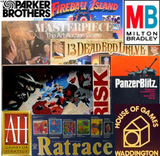There are games that rely on the roll of the dice and the luck of the draw as they are about strategy, moving tokens around a game board, drawing cards, paying money, and trying to have the most loot. Then there are games that rely on your knowledge of people and events, which tend to be known as “party” games, perhaps because there are less little game components to lose during a drunken gaming bacchanal. Of party games, there are two broad categories: those that test your knowledge of trivia, and can be played by any group, whether they are acquainted or not, and those that focus on players answering questions that deal with how well you know your fellow gamers, which means they are best played among friends. Personal Preference, a classic game first published in 1987, is one of the latter.
Game play in Personal Preference is relatively simple: during their turn players draw four cards from the category box corresponding with the game board space that their token is on. Each card has a single item, either from the “FOOD & DRINK”, “ACTIVITIES”, “PEOPLE”, or “POTPOURRI” categories, and are placed on the game board for the other players to see. (For example, drawing four cards from the “FOOD & DRINK” category box might net the player the following: “Beef jerky”, “Chocolate chip cookies”, “Garlic”, and “Pumpkin pie”.) The player then ranks those cards in order of most to least favorite, using the four color-coded Preference Cards, placing the Preference Cards into a secret envelope hidden from the other players’ view.
At that point the other players attempt to guess the secret order of the Preference Cards, placing their special Preference Tokens on the game board in order of what they think the secret ranking is. Once all players (or teams!) have committed to their preference guesses, the secret order is revealed. Correct guesses move the corresponding player’s token further along the game board, while incorrect answers can move their tokens backwards. The winning player or team is the one that manages to guess correctly enough times to move their token all the way to the FINISH square.
Personal Preference was originally published in 1987 by Broderbund (yes, the software company) in the United States, and Playtoy Industries in Canada, but was actually designed by Donal Carlston, Ph.D. Dr. Carlston is currently a professor in the Psychological Sciences department at Purdue University, and his university bio explains much of the origin of Personal Preference:
“Primary research interests are in person perception, impression formation and social cognition. The current focus of this work is on the origin, organization and use of different kinds of mental representations of people and events.”
I connected with Dr. Carlston back in 2010, and he graciously consented to an email interview, but his schedule never permitted him the time to respond to my questions, which were fairly innocuous:
1. A 1988 review of your game stated that it was designed to further familial social bonds. Would this be an accurate statement, and what was your original purpose in designing the game? Was this game an example of your research or was it an academic aside? How did the idea for the game come about?,,
2. Do you have any favorite anecdotes of your time as a game designer that you could share?,,
3. You are also credited for being a designer for the board game, Lode Runner, based on the classic computer game. Did you design other games, and have you considered returning to the industry? Do you have any advice for those that may wish to pursue a career as a game designer?
However, it’s been four years since the attempt was made; even I am willing to give up on receiving an answer after this much time has passed! This blog entry has been waiting in the queue all this time…it’s time to let it free!
Filed under: Board Games, The Best Classic Board Games | Tagged: board game, broderbund, donal carlston, personal preference, playtoy industries, psychological sciences, purdue university |













Nice blog dude. Thanks for all your help.
My parents had this game and I remember opening up the box and playing with all the pieces but never knew how it was playing. Haven’t seen this game in probably 20 years.